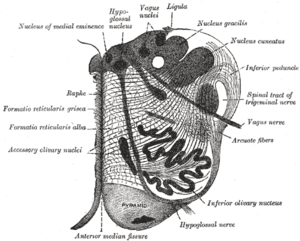Nucleus raphe magnus
| Nucleus raphe magnus | |
|---|---|
 Section of the medulla oblongata at about the middle of the olive. (Raphe nuclei not labeled, but 'raphe' labeled at left.) | |
| Details | |
| Identifiers | |
| Latin | nucleus raphe magnus |
| NeuroNames | hier-736 |
| NeuroLex ID | Nucleus raphe magnus |
| TA | A14.1.04.321 |
| FMA | 72584 |
The nucleus raphe magnus (called the magnus raphe nucleus by Terminologia Anatomica[1] and some scientific publications[2]), is located directly rostral to the nucleus raphe obscurus, and receives input from the spinal cord and cerebellum.
This makes the nucleus raphe magnus a likely candidate for part of the motor system; however, it seems to participate in the endogenous analgesia system. Mounting evidence suggests that the nucleus raphe magnus plays an important role in homeostatic regulation.[3][4]
The nucleus raphe magnus receives descending afferents from the periaqueductal grey matter, the paraventricular hypothalamic nucleus, central nucleus of the amygdala, lateral hypothalamic area, parvocellular reticular nucleus and the prelimbic, infralimbic, medial and lateral precentral cortices.[5]
All of these brain areas influence the main function of the nucleus raphe magnus.
The main function of the nucleus raphe magnus is mostly pain mediation; in fact it sends projections to the dorsal horn of the spinal cord to directly inhibit pain. The nucleus raphe magnus releases serotonin when stimulated. Raphe-spinal neurons project to enkephalin releasing interneurons in the posterior horn of the spinal cord.[6]
The periaqueductal grey matter, an area of the brain involved in mediating analgesia, sends efferent connections to the nucleus raphe magnus when it is stimulated by opiates (endogenous or otherwise).
Electrical stimulation of the PAG produces analgesia, as well as administration of morphine to the PAG or nucleus raphe magnus. The antinociceptic effects of electrical stimulation of the PAG can be blocked by administering naloxone, an opiate antagonist, to the nucleus raphe magnus.
Similarly, afferent fibres from the spinothalamic tract synapse at the periaqueductal grey matter. This in turn is linked to the nucleus raphe magnus, which when stimulated directly inhibits pain fibers in the dorsal horn of the spinal cord, thus alleviating pain.
All of this seems to indicate that the nucleus raphe magnus is part of the endogenous opiate system, and acts to inhibit pain in the spinal cord.
See also
References
- ↑ Federative Committee on Anatomical Terminology (FCAT) (1998). Terminologia Anatomica. Stuttgart: Thieme
- ↑ Anderson, D.M. (2000). Dorland’s illustrated medical dictionary (29th edition). Philadelphia/London/Toronto/Montreal/Sydney/Tokyo: W.B. Saunders Company.
- ↑ Hellman, Kevin et al. Activity of murine magnus raphe cells predicts tachypnea and on-going nociceptive responsiveness. Journal of Neurophysiology Volume 98, Issue 6, December 2007, Pages 3121-33.
- ↑ Hellman, Kevin et al., Opioid microinjection into raphe magnus modulates cardiorespiratory function in mice and rats. American Journal of Physiology Regulator Integratory Comp Physiology. Volume 297, Issue 5, November 2009, Pages R1400-8.
- ↑ Hermann, Dirk M. et al. Afferent projections to the rat nuclei raphe magnus, raphe pallidus and reticularis gigantocellularis pars demonstrated by iontophoretic application of choleratoxin (subunit b). Journal of Chemical Neuroanatomy Volume 13, Issue 1 , June 1997, Pages 1-21
- ↑ Haines, Duane E., and M. D. Ard. Fundamental Neuroscience for Basic and Clinical Applications. Philadelphia, PA: Elsevier/Saunders, 2013.